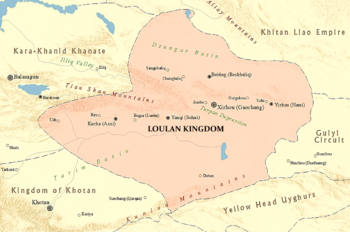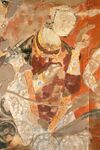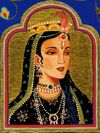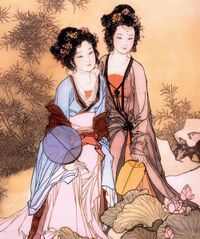Loulan Kingdom
Loulan Kingdom 𐨐𐨿𐨪𐨆𐨪𐨍𐨙𐨿𐨙𐨅𐨣𐨿𐨟𐨿𐨯𐨅 𐨩𐨤𐨆𐨩 樓蘭國 𐰚𐰺𐰆𐰺𐰃𐰣𐰃𐰣⸰𐰴𐰀𐰍𐰀𐰣𐰞𐰃𐰍𐰃 | |||||||||||||
|---|---|---|---|---|---|---|---|---|---|---|---|---|---|
| 630–1132 | |||||||||||||
 | |||||||||||||
| Capital |
| ||||||||||||
| Common languages |
| ||||||||||||
| Religion | |||||||||||||
| Government | Buddhist Despotic Monarchy | ||||||||||||
• King |
| ||||||||||||
| History | |||||||||||||
• Established | 630 | ||||||||||||
• Disestablished | 1132 | ||||||||||||
| |||||||||||||
| Today part of | Loulan, China | ||||||||||||
The Loulan Kingdom (Kroraini: 𐨐𐨿𐨪𐨆𐨪𐨍𐨙𐨿𐨙𐨅𐨣𐨿𐨟𐨿𐨯𐨅 𐨩𐨤𐨆𐨩 kroräññentse yapoy; Middle Chinese: 樓蘭國 ləulɑnkwək̚; Old Uyghur: 𐰚𐰺𐰆𐰺𐰃𐰣𐰃𐰣⸰𐰴𐰀𐰍𐰀𐰣𐰞𐰃𐰍𐰃 krorɯːn'ɯn kaɣaːnlɯ̀ɣɯ) was a medieval kingdom originally based around Kroraina, an important oasis city along the silk road. The term Loulan is a Chinese transcription of the Tocharian name for the city on the northeastern edge of the Lop desert, Kroraina, and is used to refer to both the city itself and to the kingdom as a whole. It existed from 630–1006 CE variously as a client state of the Tibetan Empire and the Tang and Liao dynasties, and from 1006–1132 as an independent Uyghur ruled state.
Prior to the incorporation of the city-state of Kroraina into the Tibetan Empire in 763 CE, it was one of the numerous quasi-independent oasis states in the Tang dynasty's Protectorate General to Pacify the West, overshadowed by the more populous and influential Tocharian kingdoms of Ārśi, Kucina, Turpan, and Qocho to the north, and the Saka kingdoms of Xotan and Shule to the west. As a Tibetan client state, the Loulan Kingdom began to expand under the reign of Gunachandra the Great, who rose to power with the support of the Tibetan emperor Trisong Detsen in 769. During Gunachandra's reign, which lasted until 817, the Loulan Kingdom united all of the former Tocharian petty kingdoms under a single authority, catapulting from the status of a city-state of negligible relevance to that of an expansive and influenctial merchant kingdom occupying several important routes of the Silk Road.
After the assassination of the Tibetan emperor Langdarma in 842, civil war broke out in the Tibetan Empire, leading to its fragmentation and a brief period of independence for the Loulan Kingdom from 842 to 845, when Queen Roce appealed to the Emperor Wuzong of Tang to annex the kingdom as a protectorate after seizing power with the assistance of a Tang general, Rèn Zhuāngsūn (任莊孫). Loulan remained a Tang protectorate until the fall of the dynasty in 907.
The character of the kingdom shifted somewhat during the 10th century: first, when King Priyadeva II (r. 902–909 CE) attempted to shift trade relations from sole dependence on China to a more balanced connection with Persia in the wake of the collapse of the Tang dynasty, in the process inviting thousands of Dehqâns fleeing the Islamization of Persia (a trend continued by his successor Priyadeva III (r. 909–929 CE)); second, when a merchant uprising in Gaochang placed Indra, an Afghan merchant, on the throne of Loulan in 929 CE. This event, along with the extensive settlement by Persian-speaking Dehqâns and Persified Afghans, who quickly found their niche in the merchant classes throughout the Kingdom, established Persian as the lingua franca and administrative language of Loulan for several generations. The resulting influence has left a large number of Western Iranian loanwords in modern Loulanese vocabulary. It is believed that Afghan settlers were responsible for introducing the Hindu festival of Diwali (Loulanese: Dipāvali, དི་པཱ་ཝ་ལི་) among other cultural contributions.
Another great change occurred when an Uyghur clan from the north, the Idiqut, invaded and overtook the kingdom. Many of the previously established political structures remained in place after the Uyghur conquest, including the use of the Persian language as the administrative language of the Kingdom. A major change was the introduction of Nestorian Christianity as a major religion in Loulan, as it was practised by the members of the Idiqut clan and many of their close companions and followers. The Kingdom was a sovereign and independent entity under the Idiqut dynasty for more than a century until its subjugation by the Western Liao in 1132.
History
Pre-dynastic period (before 769)
Some of the monarchs in the pre-dynastic period are considered to be semi-legendary, as primary sources do not exist and the only source for their existence is the epic poem, the Gunacaṃdregāthā. Of the pre-dynastic monarchs, the greatest evidence exists for the veracity of Ptoṃpile and of Siddhartha I, the latter of whom is well documented in both Chinese and Tibetan sources.
List of monarchs
| Name | Portrait | Birth | Marriages | Death | Notes |
|---|---|---|---|---|---|
| Sanlyudo c. 630 – c. 673 (43 years, 0 days) |

|
c. 600-610? | unknown | c. 673 | First named King of Kroraina named in The Hidden Flower of Loulan; allied with Emperor Tang Taizong against the Western Turks. |
| Saṃghatrāte c. 673 – c. 698 (25 years, 0 days) |
|
unknown | unknown | unknown | Relatively nothing is known about Saṃghatrāte other than his name, which is referenced in The Hidden Flower. |
| Ptoṃpile c. 698 – c. 728 (30 years, 0 days) |

|
unknown | unnamed Tang princess 3 children |
c. 728 | Ally of Emperor Xuanzong of Tang. First Kroraini king for which evidence is not dubious. |
| Cakravār c. 728 – c. 765 (37 years, 0 days) |

|
unknown | unknown | c. 765 | Submitted to the rule of Me Agtsom, bringing Loulan under the rule of the Tibetan Empire. |
| Siddhartha I c. 767 – 12 February 769 (2 years, 0 days) |

|
c. 742 | Argiyotisāe 3 children unnamed Tangut woman 2 children |
13 November 785 Aged about 43 |
May have been a relative of Cakravār. Led a minor uprising against Trisong Detsen of Tibet and was deposed and replaced with Gunachandra. |
Gunachandra Dynasty
The Gunachandra dynasty was the longest-ruling dynasty of the Loulan Kingdom, beginning with the appointment of Gunachandra the Great by the Tibetan emperor Trisong Detsen. It is sometimes known as the Deyue dynasty after Gunachandra's Chinese name, Déyuè (德月).
Although Sanlyudo is the earliest known ruler of Loulan, Gunachandra is considered by most to be the founder of the Loulan Kingdom, uniting most of the northern and western Tarim Basin.
Despite the dynasty's auspicious beginnings with Gunachandra, the middle and later periods of the dynasty were marked by rampant dynastic infighting, intrigue, and civil wars.
List of monarchs
| Name | Portrait | Birth | Marriages | Death | Claim | Notes |
|---|---|---|---|---|---|---|
| Gunachandra "the Great" 12 February 769 – 26 February 817 (48 years, 15 days) |

|
c. 744 | Tsame 6 children Maya 2 children Bum 1 son |
26 February 817 Aged 73 |
Appointed by Trisong Detsen of Tibet | Appointed to pacify the Tocharian dependencies of the Tibetan Empire. Famously united the northern and western Tarim Basin and made peace with the Uyghur Khanate. |
| Kshmavarma 26 February 817 – 29 December 823 (6 years, 307 days) |
|
22 March 774 Son of Gunachandra and Bum |
Purgyal Lha 4 children Shang Drablai 1 daughter |
29 December 823 Committed suicide aged 49 |
Third son of Gunachandra Inheritance |
Third and favoured son of Gunachandra. Secured the Turpan Depression. |
| Siddhartha II 29 December 823 – 8 December 829 (5 years, 345 days) |
|
20 December 805 Son of Kshmavarma and Purgyal Lha |
Ayardhyame 1 daughter Gülçiçek 2 daughters |
8 December 829 Aged 24 |
Third son of Kshmavarma Inheritance |
Youngest son of Kshmavarma. Killed in battle against Uyghur raiders. |
| (1st reign) Roce 8 December 829 – 14 July 831 (1 year, 219 days) |

|
21 February 824 Daughter of Siddhartha II and Ayardhyame |
Ye Hong 4 children Poyul Lhawang 1 daughter Kausal 1 daughter |
9 May 862 Allegedly murdered aged 38 |
Daughter of Siddhartha II Primogeniture |
Child queen. Deposed in favour of her great uncle, Wrauske I. |
| Wrauske I 14 July 831 – 16 January 841 (9 years, 187 days) |
|
18 February 770 Son of Gunachandra and Tsame |
Khon Purbulcam 4 children Qaraqaz 1 son Baninera 2 daughters |
16 January 841 Aged 71 |
First son of Gunachandra Installed by noble demand |
Eldest son of Gunachandra. Killed in a duel with a rival. Controversial for the murder of his second wife, the Uyghur princess Qaraqaz. |
| Siddhartha III 14 July 831 – 12 August 845 (4 years, 209 days) |
|
1 December 789 Son of Wrauske I and Khon Purbulcam |
Zhongyang 1 son |
25 May 847 Aged 58 |
First son of Gunachandra Installed by noble demand |
Broke ties with Tibetan Empire. Deposed by claimant Roce with the support of the Tang Empire. |
| (2nd reign) Roce 12 August 845 – 11 March 857 (11 years, 212 days) |

|
21 February 824 Daughter of Siddhartha II and Ayardhyame |
Ye Hong 4 children Poyul Lhawang 1 daughter Kausal 1 daughter |
9 May 862 Allegedly murdered aged 38 |
Daughter of Siddhartha II Conquered as claimant. |
Ousted Siddhartha III with the help of the Tang general Rèn Zhuāngsūn (任莊孫). From 845 to 850 disputed rule with Wrauske II. |
| (disputed) Wrauske II December 17 845 – 5 May 850 (4 years, 140 days) |
|
11 September 798 Son of Kshmavarma and Purgyal Lha |
Özlem 1 daughter |
14 February 867 Aged 69 |
First son of Kshmavarma Conquered as claimant |
Took control of the Turpan Basin. Forced to relinquish claim in 850. |
| Priyadeva 11 March 857 – 1 August 861 (4 years, 144 days) |
|
9 October 797 Son of Kentarske and Ibilgä |
Örün 6 children Purnaya 2 children |
20 February 873 Aged 76 |
Grandson of Gunachandra Conquered as claimant |
Grandson of Gunachandra and Maya via their son Kentarske.
|
| (3rd reign) Roce 1 August 861 – 9 May 862 (282 days) |

|
21 February 824 Daughter of Siddhartha II and Ayardhyame |
Ye Hong 4 children Poyul Lhawang 1 daughter Kausal 1 daughter |
9 May 862 Allegedly murdered aged 38 |
Daughter of Siddhartha II Conquered as claimant. |
Final reign. Allegedly murdered in 862. |
| Siddhartha IV 9 May 862 – 23 August 888 (26 years, 107 days) |
|
16 January 848 Son of Roce and Ye Hong |
Li Diaochan 2 daughters Liang Zhong 2 children |
23 August 888 Aged 40 |
Son of Roce Inheritance |
First Loulanese monarch to practice Daoism rather than Buddhism. Slain in battle against Uyghur raiders. |
| Nanda 23 August 888 – 2 August 890 (1 year, 345 days) |
|
21 August 884 Son of Siddhartha IV and Liang Zhong |
unmarried | 2 August 890 Aged 6 |
Son of Siddhartha IV Inheritance |
Child king. Murdered in cold blood by live burial by Siddhartha V after a palace coup. |
| Siddhartha V "the Cruel" 2 August 890 – 31 July 893 (2 years, 364 days) |
|
1 October 844 Son of Siddhartha and Zhongyang |
unmarried | 31 July 893 Allegedly murdered aged 58 |
Grandson of Wrauske I Usurpation |
Grandson of Wrauske I and Khon Purbulcam via their son Siddhartha. Daoist. Allegedly murdered in 893.
|
| Tati 31 July 893 – 15 September 902 (9 years, 47 days) |

|
16 February 843 Daughter of Roce and Ye Hong |
Khan Erin 4 daughters Bökiye 1 daughter Wisikke Kausali 2 children |
15 September 902 Aged 59 |
Daughter of Roce Installed by noble demand |
Last ruler of the Gunachandra dynasty. Daoist. |
Kausali Dynasty
List of monarchs
| Name | Portrait | Birth | Marriages | Death | Claim | Notes |
|---|---|---|---|---|---|---|
| Priyadeva II 15 September 902 – 9 October 909 (7 years, 24 days) |
|
1 September 865
Son of Tati and Wisikke Kausali |
Arjune 4 children |
9 October 909 Aged 40 |
Son of Tati Inheritance |
Restored Buddhism to the palace. Died of poor health. |
| Priyadeva III "the Mutilator" 9 October 909 – 31 July 929 (19 years, 295 days) |
|
13 February 903
Son of Priyadeva II and Arjune |
Güneş 3 sons Kosthile 2 children 2 other children by concubines |
16 May 973 Aged 70 |
Son of Priyadeva II Inheritance |
Known for his excessive cruelty. Deposed by an uprising of Tajik and Pathani merchants. |
Zalmaizai dynasty
The Zalmaizai dynasty, also known as the Afghani or Pathani dynasty for their Pashtun origins, rose to power during a merchant uprising in Gaochang which overthrew the previous reigning monarch, Priyadeva III, in 929 CE. The head of one of the merchant guilds, a Pathani man named Patwal, was installed by the rebelling merchants. Patwal, a Hindu, took the regnal name Indra after the Hindu guardian deity.
The Persianisation of Loulan accelerated during the Zalmaizai period, as the Pathan king Indra spoke no Kroraini — but he did speak Persian fluently, and made it the language of his administration. A further influx of Dehqân settlement from the 960s to 1000 CE, coinciding with the wars between the Samanids and the Ghaznavids, caused a great deal of Persian vocabulary to enter the Loulanese vernacular.
During the Zalmaizai period, syncretic elements of Hinduism seeped into the local Buddhist sect — most notably the celebration of Diwali and reverence for the goddess Padme.
List of monarchs
| Name | Portrait | Birth | Marriages | Death | Claim |
|---|---|---|---|---|---|
| Indra 31 July 929 – 4 April 939 (9 years, 247 days) |
|
c. 893
Son of Zalmai |
Kashmala 3 children Purike (no children) 2 other children by concubines |
4 April 939 Aged about 46 |
Usurpation |
| Chandra 4 April 939 – 26 October 987 (48 years, 205 days) |

|
12 March 928
Son of Indra and Roce Nyantsentkacer |
Sumagati 1 daughter Ötüken (no children) 4 other children by concubines |
26 October 987 Aged 59 |
Son of Indra Inheritance |
| Trinayani 26 October 987 – 1 January 1001 (13 years, 67 days) |

|
8 September 945
Daughter of Chandra and Sumagati |
Yudisthira 4 children |
1 January 1001 Aged 55 |
Daughter of Chandra Inheritance |
